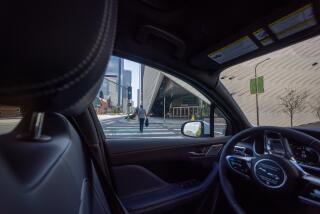John Bryson and seizures while driving: How common are they?
Suffering a seizure while behind the wheel, as U.S. Commerce Secretary John Bryson reportedly did, is extremely rare but is far more likely to end in death than seizures suffered elsewhere, according to federal transportation experts.
A spokeswoman for Bryson, who was cited for felony hit-and-run after his car struck two other vehicles Saturday evening in the San Gabriel Valley, said Bryson had suffered a seizure. “He was taken to the hospital for examination and remained overnight for observation. He was released and has returned to Washington,” department spokeswoman Jennifer Friedman told The Times.
Bryson was cooperative with authorities, officials said, adding that an investigation remains underway. The 68-year-old had given a commencement address Thursday at Pasadena’s Polytechnic School, which several of his daughters attended.
Neurologist Dr. Sean Hwang of the Cushing Neuroscience Institute, part of North Shore-LIJ Health System in Great Neck, N.Y., said Bryson needs a full battery of medical tests to get to the bottom of the incident.
“What was described sounded very concerning,” Hwang told The Times. “We always worry about what could be the possible underlying causes.”
The federal Centers for Disease Control and Prevention says there are two main types of seizures -- primary generalized seizures involving both sides of the brain and partial seizures involving smaller regions of the brain. Sometimes seizures indicate epilepsy, but not always, it explains.
As for the risks associated with driving, the Stanford School of Medicine’s Epilepsy Center notes that, each year, 5% to 10% of Americans crash a car. “For people with epilepsy, the rate is about 30% to 50% higher,” it notes. “While that sounds alarming, a 50% risk increase is far below the higher crash risk for drinking drivers, young male drivers or elderly drivers.”
As for other causes of seizure, Hwang said they could range from the relatively minor -- a sleep disorder -- to the critical, such as a brain tumor or cardiac problem.
Anyone who suffers from such “unexplained episodes of alterations of awareness” should seek medical attention to determine whether the person is at risk for further seizures or whether he or she has a pressing medical condition. Likely tests would include a blood analysis, a brain-wave test and EKG monitoring.
Hwang also cautioned that anyone who has a medical episode while driving should refrain from driving again until cleared by a physician.
Further, he said, such drivers should check with their state’s motor vehicle department. Rules vary from state to state, but some people might be barred from driving for a period of time while their medical condition remains unresolved.
Here are some facts about car crashes linked to medical conditions -- not just seizures -- from a 2009 report issued by the National Highway Traffic Safety Administration:
--Such incidents are rare. Authorities say only 1.3% of all drivers have been involved in a crash precipitated by a medical emergency.
--Age is often a factor. Older drivers are more likely to be involved in a crash following a medical emergency than young and middle-age drivers.
--The medical condition that precipitates such a crash usually is not a mystery. Drivers who suffered seizures, blackouts or diabetic reactions at the wheel were usually well aware of the medical condition associated with the crash.
--Such crashes frequently end in death. “Drivers in crashes precipitated by medical emergencies were more likely than other drivers to be more severely injured or to die as a result of the crashes.”
--Mornings are more dangerous. “Drivers who had crashes that have been precipitated by medical emergencies were more likely to be involved in crashes during the morning hours between 6 a.m. and 11:59 a.m. when compared to other drivers.”
The report notes: “There is a growing concern about risks associated with driving for people with known medical conditions. However, the association between having a chronic medical condition and being involved in a motor vehicle crash remains controversial.” (That could be because taxpayers are not keen on having their driving privileges restricted because of diabetes or epilepsy.)
There are suggestions that medical-related car crashes could be a serious, possibly growing, problem.
The NHTSA report cited a 2005 Centers for Disease Control and Prevention statistic that said 133 million Americans were living with at least one chronic condition, a number that has risen in recent years. That means more people may be driving with conditions that could precipitate a medical emergency behind the wheel.
What to do about such car crashes? The NHTSA suggests that healthcare providers better educate their patients about the side effects of medications and medical conditions.
The agency also recommended safety technologies such as the Drowsy Driver Warning System. A “lane departure prevention system” can also help, the study says.
ALSO:
Blackhawk helicopters called in to Colorado wildfire
Could the end be near for Occupy Wall Street movement?
Supreme Court turns down appeal from Guantanamo Bay detainees
Join Rene Lynch on Google+ or Twitter. Email: rene.lynch@latimes.com
More to Read
Sign up for Essential California
The most important California stories and recommendations in your inbox every morning.
You may occasionally receive promotional content from the Los Angeles Times.











